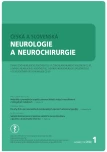Multiple tumefactive brain lesions as the first symptoms of demyelination
Authors:
M. Petrášová 1,2; J. Kolčava 1,2; J. Kočica 1,2; P. Hložanka 2,3; P. Štourač 1,2
Authors‘ workplace:
LF MU a FN Brno
1; Neurologická klinika FN Brno
2; Klinika radiologie a nukleární medicíny, FN Brno
3
Published in:
Cesk Slov Neurol N 2022; 85(1): 86-88
Category:
Letters to Editor
doi:
https://doi.org/10.48095/cccsnn202286
Sources
1. Masdeu JC, Quinto C, Olivera C et al. Open-ring imaging sign: highly specific for atypical brain demyelination. Neurology 2000; 54 (7): 1427–1433. doi: 10.1212/wnl.54.7.1427.
2. Sánchez P, Meca-Lallana V, Barbosa A et al. Tumefactive demyelinating lesions of 15 patients: clinico-radiological features, management and review of the literature. J Neurol Sci 2017; 381 : 32–38. doi: 10.1016/ j.jns.2017.08.005.
3. Štourač P, Kolčava J, Keřkovský M et al. Progressive tumefactive demyelination as the only result of extensive diagnostic work-up: a case report. Front Neurol 2021; 12 : 701663. doi: 10.3389/fneur.2021.701663.
4. Frederick MC, Cameron MH. Tumefactive demyelinating lesions in multiple sclerosis and associated disorders. Curr Neurol Neurosci Rep 2016; 16 (3): 26. doi: 10.1007/s11910-016-0626-9.
5. Algahtani H, Shirah B, Alassiri A. Tumefactive demyelinating lesions: a comprehensive review. Mult Scler Relat Disord 2017; 14 : 72–79. doi: 10.1016/ j.msard.2017.04.003.
6. Thompson AJ, Banwell BL, Barkhof F et al. Diagnosis of multiple sclerosis: 2017 revisions of the McDonald criteria. Lancet Neurol 2018; 17 (2): 162–173. doi: 10.1016/S1474-4422 (17) 30470-2.
7. Gnanapavan S, Jaunmuktane Z, Baruteau KP et al. A rare presentation of atypical demyelination: tumefactive multiple sclerosis causing Gerstmann’s syndrome. BMC Neurol 2014; 14 : 68. doi: 10.1186/1471-2377-14-68.
8. Given CA, Stevens BS, Lee C. The MRI appearance of tumefactive demyelinating lesions. AJR Am J Roentgenol 2004; 182 (1): 195–199. doi: 10.2214/ajr.182.1.1820195.
9. Turatti M, Gajofatto A, Bianchi MR et al. Benign course of tumour-like multiple sclerosis. Report of five cases and literature review. J Neurol Sci 2013; 324 (1–2): 156–162. doi: 10.1016/j.jns.2012.10.026.
10. Hardy TA. Pseudotumoral demyelinating lesions: diagnostic approach and long-term outcome. Curr Opin Neurol 2019; 32 (3): 467–474. doi: 10.1097/WCO. 0000000000000683.
Labels
Paediatric neurology Neurosurgery NeurologyArticle was published in
Czech and Slovak Neurology and Neurosurgery

2022 Issue 1
- Metamizole vs. Tramadol in Postoperative Analgesia
- Memantine in Dementia Therapy – Current Findings and Possible Future Applications
- Metamizole at a Glance and in Practice – Effective Non-Opioid Analgesic for All Ages
- Advances in the Treatment of Myasthenia Gravis on the Horizon
Most read in this issue
- Multiple tumefactive brain lesions as the first symptoms of demyelination
- Spontaneous intracranial hypotension
- Deep brain stimulation advances in neurological diseases
- Analytical and pre-analytical aspects of neurofilament light chain determination in biological fluids
